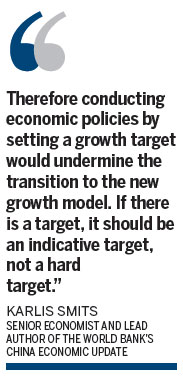Reforms rather than targets should be priority, says World Bank report
China's growth is expected to ease to slightly above 7 percent next year and the government should focus on reforms to rebalance the economy instead of trying to meet specific targets, the World Bank said on Wednesday.
The growth model in China is changing and its growth is increasingly becoming determined by market forces, said Karlis Smits, senior economist and lead author of the World Bank's China Economic Update released on Wednesday.

"Therefore conducting economic policies by setting a growth target would undermine the transition to the new growth model. If there is a target, it should be an indicative target, not a hard target," said Smits.
He said whether to set a target or not is a "political choice" of the government, but there are more important ones like wage growth and environmental targets that need to be prioritized.
Last week, Yu Bin, director of research at the Department of Macroeconomic Research, under the Development Research Center of the State Council, said there are different voices among the leading think tanks about next year's growth target.
"There are disputes among our team over this issue. Is it possible to shift the target to a range, for example, between 7 and 7.5 percent, or is it possible to abandon setting a target?" Yu said after a press conference on Friday, adding that China's growth could reach 7 percent next year.
Growth in China came in at 7.3 percent in the third quarter from a year earlier, the lowest since the global financial crisis. Some think China's economic slowdown will continue in the coming years but that's far from a hard landing.
China will face "an orderly slowdown over the medium term", said Smits.
The government has made progress in rebalancing the economy in terms of tackling credit growth and taking steps to tighten budget constraints for local governments and formalize the way of issuing debts, he said.
The key short-term policy challenge is to strengthen market discipline in the financial sector.
In the medium term, the challenge is to keep the reform momentum going, according to the report.
Financial industry reform is "not slowing but progressing more gradually" than other ambitious reform initiatives, said Smits.
"Our biggest concerns in term of risks are that if financial sector market forces are not strengthened, this will continue to weaken the financial sector and contribute to misallocation of capital," he said.
China has sufficient policy buffers, but against a backdrop of uncertain global economic environment, the buffers should be reserved to maintain overall macroeconomic stability in case of unexpected domestic or external economic shocks, he said.
The World Bank lowered China's growth forecast for 2014 to 7.4 percent largely due to weaker-than-expected domestic economic activity.
Policy efforts to tighten credit growth, reduce excess capacity, internalize the cost of industrial pollution, and harden budget constraints of local governments intensified in 2014, said Chorching Goh, the World Bank's lead economist for China.
Especially important will be policies that facilitate the movement of resources from sectors with excess capacity, notably measures to gradually remove State guarantees and allow inefficient firms, including State-owned enterprises, to fail, said the report.
"This will require a careful balancing between enhancing market discipline and avoiding disruptions to the labor market," it said.
|
 |
 |
| Top 12 economic data of China in Sept | When less might actually mean more |
